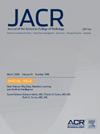Artificial Intelligence in Radiology: A Leadership Survey
IF 5.1
3区 医学
Q1 RADIOLOGY, NUCLEAR MEDICINE & MEDICAL IMAGING
引用次数: 0
Abstract
Purpose
Surveys to assess views about artificial intelligence (AI) of various diagnostic radiology constituencies have revealed interesting combinations of enthusiasm, caution, and implementation priorities. We surveyed academic radiology leaders about their views on AI and how they intend to approach AI implementation in their departments.
Materials and methods
We conducted a web survey of Society of Chairs of Academic Radiology Departments members between October 5 and October 31, 2023, to solicit optimism or pessimism about AI, target use cases, planned implementation, and perceptions of their workforce. P values are provided only for descriptive purposes and have not been adjusted for multiple testing in this exploratory research.
Results
The survey was sent to the 112 Society of Chairs of Academic Radiology Departments members and 43 responded (38%). Chairs were optimistic, with no statistical difference between views of AI in general versus generative AI. Chairs plan to implement AI to improve quality and efficiency (43 of 43, 100%), burnout (41 of 43, 95%), health care costs (22 of 43, 51%), and equity (27 of 43, 63%) and most likely will target the postprocessing (26 of 43, 60%), interpretation workflow (26 of 43, 60%), and image acquisition (18 of 43, 42%) steps in the imaging value chain. Chairs perceived that radiologists (36 of 43, 84%) and technologists (38 of 43, 88%) were not particularly worried about being displaced but saw trainees as slightly less confident (31 of 43, 72%). Free text responses revealed concerns about the cost of AI and emphasized trade-offs that needed to be balanced.
Conclusion
Radiology chairs are optimistic about AI and poised to tackle departmental challenges. Concerns about generative AI and workforce replacement are minimal.
放射学中的人工智能:领导力调查。
目的:对各种诊断放射学选区对人工智能(AI)的看法进行的调查显示了热情、谨慎和实施优先级的有趣组合。我们调查了学术放射学领导者对人工智能的看法,以及他们打算如何在他们的部门实施人工智能。材料和方法:我们在2023年10月5日至10月31日期间对学术放射科主席协会(SCARD)成员进行了一项网络调查,以征求对人工智能、目标用例、计划实施以及对其劳动力的看法的乐观或悲观情绪。p值仅用于描述目的,在本探索性研究中未对多重检验进行调整。结果:将问卷发送至112名SCARD会员,43名会员回复(38%)。主席们持乐观态度,对人工智能的看法在总体上与生成式人工智能之间没有统计学差异。主席们计划实施人工智能,以提高质量和效率(43/ 43,100%)、职业倦怠(41/ 43,95%)、医疗成本(22/ 43,51%)和公平性(27/ 43,63%),并且最有可能针对成像价值链中的后处理(26/ 43,60%)、解释工作流程(26/ 43,60%)和图像采集(18/ 43,42%)步骤。主席认为放射科医生(36/ 43,84%)和技术专家(38/ 43,88%)并不特别担心被取代,但认为实习生的信心略低(31/ 43,72%)。自由文本回应揭示了对人工智能成本的担忧,并强调了需要平衡的权衡。结论:放射科主任对人工智能持乐观态度,并准备好应对部门挑战。对生成式人工智能和劳动力替代的担忧微乎其微。
本文章由计算机程序翻译,如有差异,请以英文原文为准。
求助全文
约1分钟内获得全文
求助全文
来源期刊

Journal of the American College of Radiology
RADIOLOGY, NUCLEAR MEDICINE & MEDICAL IMAGING-
CiteScore
6.30
自引率
8.90%
发文量
312
审稿时长
34 days
期刊介绍:
The official journal of the American College of Radiology, JACR informs its readers of timely, pertinent, and important topics affecting the practice of diagnostic radiologists, interventional radiologists, medical physicists, and radiation oncologists. In so doing, JACR improves their practices and helps optimize their role in the health care system. By providing a forum for informative, well-written articles on health policy, clinical practice, practice management, data science, and education, JACR engages readers in a dialogue that ultimately benefits patient care.
 求助内容:
求助内容: 应助结果提醒方式:
应助结果提醒方式:


